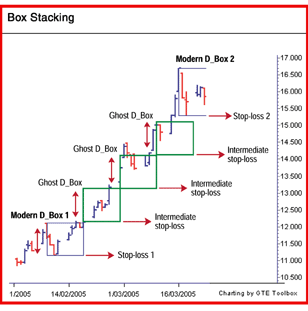Modifying The Darvas Technique For Today's Markets
Something Darvas, Something New
by Daryl Guppy
In the May 2005 STOCKS & COMMODITIES, Daryl Guppy discussed classic Darvas-style trading. Here, he modifies the technique to fit modern-day markets, given that markets are more volatile these days than they were in the 1960s.
The increased volatility of modern-day trading has reduced the risk control elements of the Darvas approach, which was originally developed and applied to less volatile markets. The Darvas box and trailing-stop approach is designed to keep you in a long-term steady trend, since the stop-loss level remains unaltered for extended periods in the face of substantial price moves. But in the volatile markets of today, this kind of strategy could expose you to an unexpectedly high level of risk. To bring this classic trading style into modern markets, I made four modifications. Each modification is consistent with the underlying logic of the Darvas method.
MODERN DARVAS RULES
The new rules are shown in bold:
- Trade is initiated by a new high for the rolling 12- or six-month period.
- All entry decisions are based on the high of the price series.
- All exit decisions are based on the close of the series.
- Entry action is triggered by the first trade at the trigger price.
- Exit action is managed on the day after the trigger close.
- Action is triggered by the close.
- Stop-loss calculation uses ghost boxes where necessary to handle modern volatility.
The most significant change is using the close to initiate trade entries and exits. Although this is only a minor change, it does substantially increase the reliability of Darvas-style trading in modern markets.
Since the Darvas trading approach was developed in a market where high volatility was unusual, the original approach used the bottom of the most recent D_Box as a stop-loss point. The stop-loss point was only raised after a new D_Box had been formed. The stop-loss is lifted upward on a regular basis and does not lag far behind the current price action.
In modern markets, prices often move upward very quickly in a typical momentum-driven sharp trend. There is no threat to the underlying trend in this action, but the speed of the move is not adequately managed using the Darvas stop-loss approach. To accommodate for this, I developed a "ghost" D_Box (Figure 1).

FIGURE 1: BOX STACKING. Here, ghost D_Boxes are used as a volatility stop-loss solution. Note how the trailing stops are based on the height of the last box.
Excerpted from an article originally published in the June 2005 issue of Technical Analysis of STOCKS & COMMODITIES magazine. All rights reserved. © Copyright 2005, Technical Analysis, Inc.
Return to June 2005 Contents